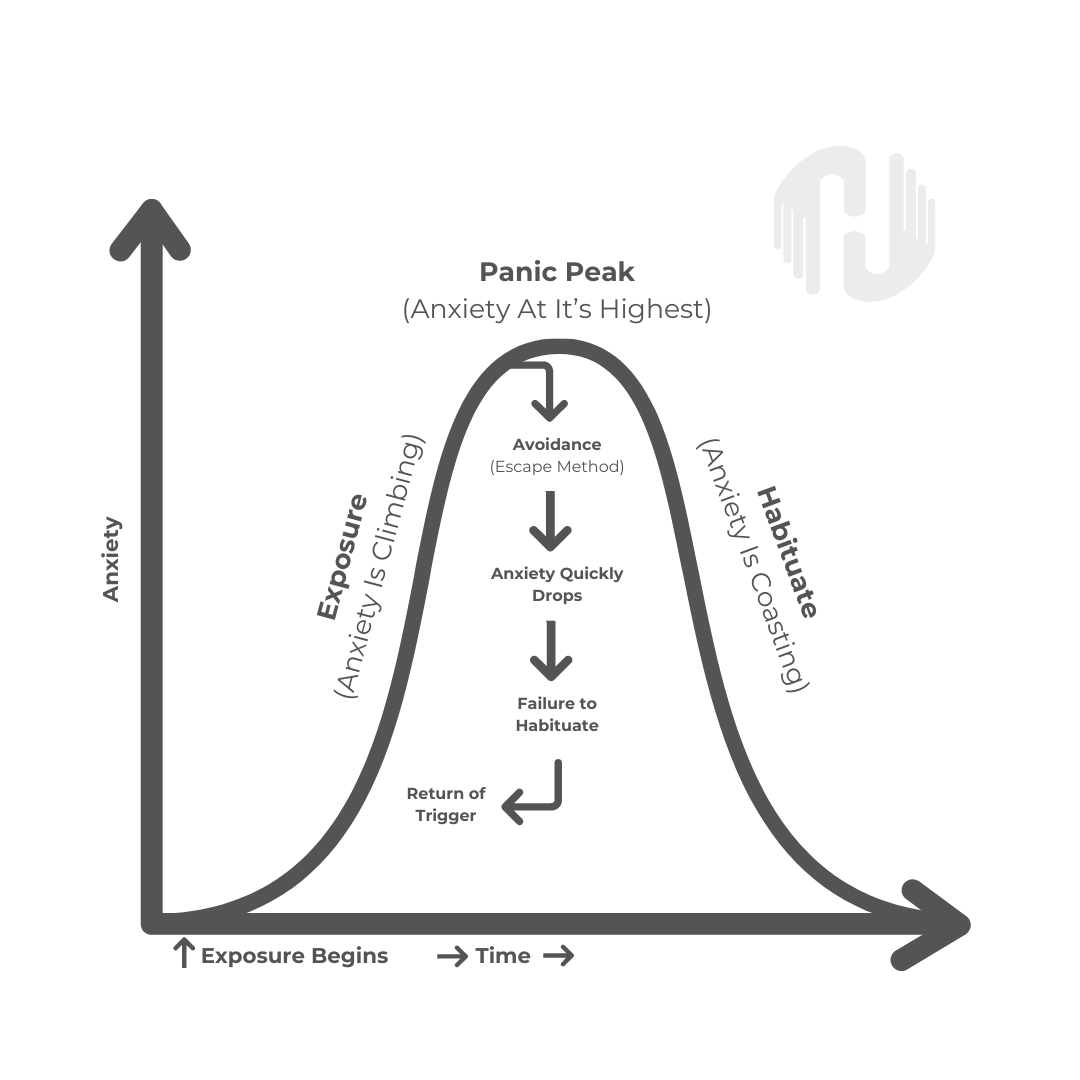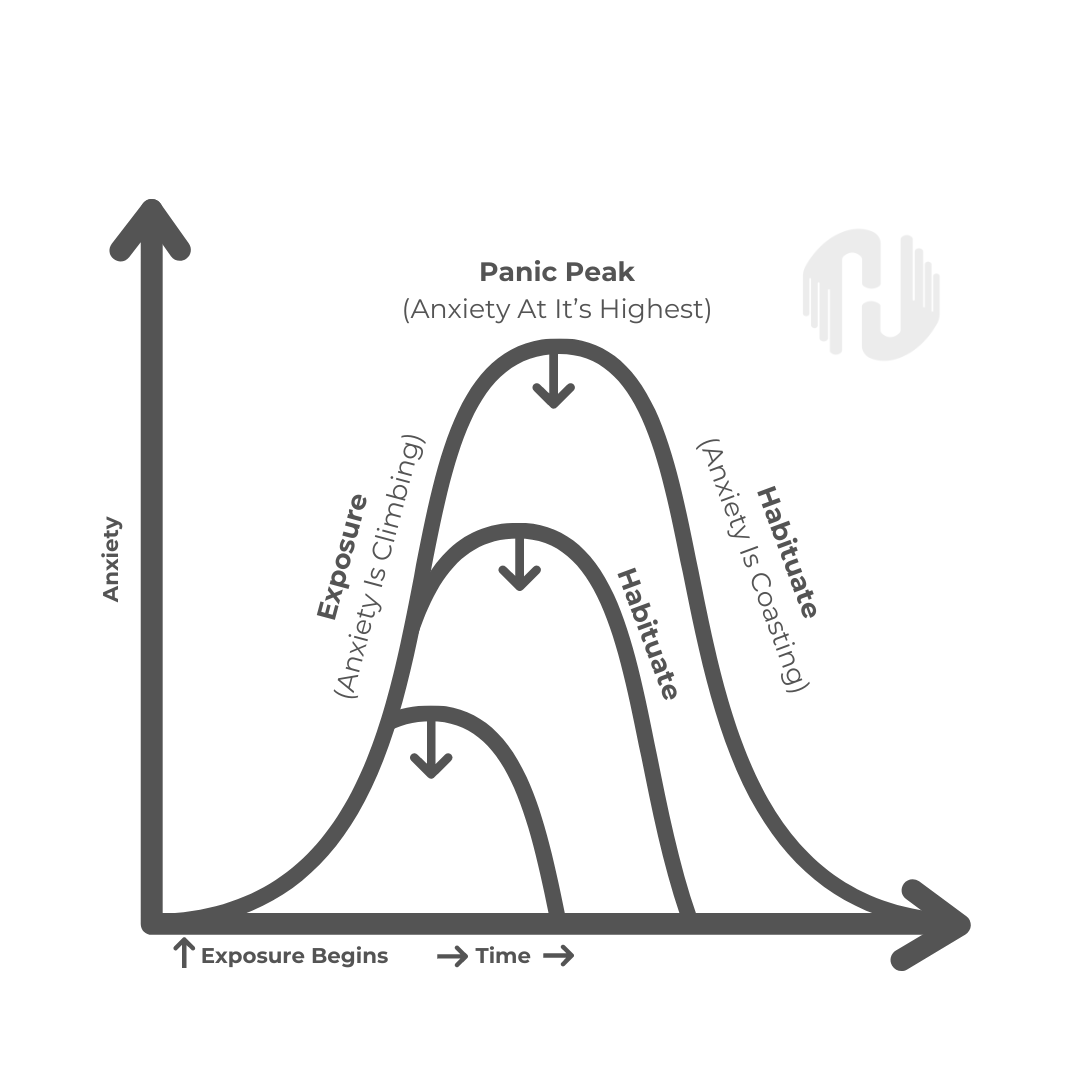The 9 Biggest Anxiety Myths: What Everyone Gets Wrong About Anxiety
At Horn Counseling, we are driven by the transformative power of understanding. We recognize that when complex issues are simplified and understandable, changes can occur in an individual’s life. By actively dispelling myths surrounding anxiety, we spread essential knowledge and empower individuals to thrive. In this blog, we will build on the insights from our previous post, diving deeper into the power of habituation. As we unravel and challenge common misconceptions about anxiety, our goal is to illuminate paths to greater mental health and well-being, helping our community to navigate their journeys with the understanding, confidence, and support you deserve.
Role of Habituation in Recognizing and Treating Clinical Anxiety
Anxiety is more than just pre-event nerves. It can be a relentless condition that takes over your daily life. Habituation, a central cognitive-behavioral therapy (CBT) technique, is a powerful tool in treating anxiety. This approach involves repeatedly and systematically exposing individuals to the things they fear in a safe environment to teach the brain to dial down the fear response. This exposure helps individuals understand that their intense anxiety does not necessarily signal impending danger.
Consider the case of a client I was working with who was overwhelmed by the thought of getting his driver's license after putting it off until later in life. We devised a step-by-step plan that began with less distressing tasks, like visiting the DMV parking lot, and gradually worked up to more challenging ones, like entering the DMV and eventually applying for the license. This method of habituation allowed him to face his fears systematically. Each successful exposure significantly lowered his anxiety levels, bringing him closer to his goal. Ultimately, he was able to get his license with much less distress.
Importance of Dispelling Myths
Debunking myths about anxiety is essential because it fosters understanding. Misconceptions can create barriers not just for those directly affected but also for their loved ones who could offer help. By dispelling these myths, we do more than share information; we build bridges of support and understanding.
Challenging these myths allows individuals to identify signs of anxiety in themselves and others, promoting an environment where curiosity and support flourish and judgment fades. This understanding is vital—it helps us distinguish between everyday stress and serious mental health issues, encouraging timely and appropriate help.
Dispelling these myths helps dismantle the stigma that often isolates those affected, preventing them from seeking help and potentially worsening their condition. Open, honest discussions about anxiety contribute to a more empathetic and compassionate society, making it easier for individuals to offer or seek help.
Ultimately, addressing these misconceptions enriches our collective empathy and strengthens community bonds, creating a supportive atmosphere where mental well-being is prioritized, and everyone is encouraged to support each other in their mental health journeys.
Common Myths and Facts About Anxiety
Myth 1: Anxiety disorders aren't real because everyone has anxiety
Fact: Anxiety is a Legitimate Psychiatric Condition
Understanding stress and anxiety is crucial, as they are often mistakenly seen as insignificant. It's important to recognize that anxiety disorders are distinct from every day worries. According to the fifth edition of the Diagnostic and Statistical Manual of Mental Health (DSM-5), generalized anxiety disorder (GAD) is characterized by persistent, excessive anxiety that occurs on most days for at least six months. For a diagnosis, this anxiety must be difficult to control and significantly disrupt daily functioning. Simply put, while stress is a common response to challenges in life, anxiety disorders amplify this response to a debilitating level.
Anxiety disorders are not rare; they affect over 40 million adults in the U.S. alone—nearly one in five adults. These conditions can manifest in various ways: some individuals might display obvious physical symptoms like panic attacks, making their struggle apparent, while others might suffer silently, their symptoms invisible to those around them.
Myth 2: Anxiety Will Go Away On Its Own
Fact: Anxiety requires intentional interventions
Many people mistakenly think that anxiety will disappear over time, much like a common cold. However, this misconception can be harmful. Without proper attention and treatment, anxiety can deeply entrench itself in someone's everyday life, transforming fleeting worries into persistent and disruptive presences.
How Habituation Challenges the Idea That Anxiety Resolves Without Intervention
Imagine you have a slow but persistent water leak in your home. You might place a bucket under the drip, hoping it'll stop on its own. Yet, as time passes, the problem often worsens, leading to more damage and the need for more significant repairs. Similarly, ignoring anxiety doesn't make it disappear; it typically festers and grows, potentially evolving into more severe disorders.
Habituation involves repeated, controlled exposure to the sources of one’s anxiety. It is effective because it helps retrain the brain to stop perceiving these sources as threats, diminishing the anxiety response over time. As seen in the habituation diagram, if we use avoidance or an escape method, we start a loop. We are then stuck on an anxiety rollercoaster of sorts, continually building anxiety every time we are faced with a trigger or exposed to an anxiety-producing situation. Habituation is a way to "patch" the leak in your mental well-being through consistent maintenance rather than waiting for it to fix itself.
Engaging in habituation means facing fears in a structured and deliberate manner, which can initially seem daunting. However, isn't it far more empowering to confront these fears rather than allow them to dictate the terms of your life? This proactive approach not only helps reduce anxiety symptoms but also builds resilience and coping skills that benefit all areas of life. Notice in the diagram that through habituation and allowing yourself to ride the rollercoaster thorough naturally. The panic peak gets smaller and smaller, creating less of a reaction.
In essence, treating anxiety requires active intervention, not passive hope. By understanding and applying principles of habituation, individuals can reclaim control from their anxieties, leading to a healthier, more balanced life. Why wait for anxiety to possibly fade when you can take steps now to mitigate its impact and enhance your overall well-being? Isn't it time we all took control of our mental health, just as we would with any other critical aspect of our lives?
Myth 3: People With Anxiety Should Just Avoid Stressful Situations
Fact: Stressful situations are a part of everyday life, and we have to develop ways to face life in healthy, safe and effective ways
There's a common belief that the best way for people with anxiety to manage their symptoms is to avoid stressful situations altogether simply. The idea is that by steering clear of stressors, individuals can prevent the onset of anxiety symptoms and live a more comfortable life.
However, this approach is not only impractical but also counterproductive. Stressful situations are an inevitable part of life, and avoiding them can actually limit opportunities for personal growth and the development of effective coping mechanisms. By constantly avoiding stress, individuals may inadvertently reinforce their anxiety, making it even more daunting when they inevitably have to face a challenging situation.
Learning to cope with stress effectively is crucial for anyone, especially for those dealing with anxiety disorders. Rather than avoidance, the focus should be on developing robust coping strategies that empower individuals to face their fears and manage their reactions in a healthy way.
By facing stressful situations with the right tools, people can build resilience over time. This not only reduces the impact of anxiety in the moment but also contributes to a long-term decrease in overall anxiety levels. Each exposure to stress, handled successfully, builds confidence and reinforces the person's ability to cope, creating a positive feedback loop.
Using Habituation as a Method to Face and Overcome Stressors
It's a common belief that avoiding stress is the best way to manage anxiety. However, this approach is much like putting a Band-Aid on a broken arm—it offers a temporary solution but doesn't address the underlying issue. Stress is an unavoidable aspect of life; it meets us at work, at home, and in our relationships. By consistently avoiding stressful situations, individuals may inadvertently shrink their world, missing out on opportunities and experiences that could bring joy and fulfillment.
This is where the concept of habituation steps in as a transformative approach. Rather than sidestepping every stressor, effective coping strategies developed through habituation can lead to a more robust, fearless approach to life. Engaging with challenges, rather than evading them, equips individuals with resilience and adaptability. Over time, what once seemed daunting becomes manageable and less intimidating, paving the way for personal growth and confidence.
Isn't facing life head-on far more empowering and sustainable, armed with strategies that turn stress into a catalyst for strength? With habituation, we not only survive the challenges of life but thrive in spite of them.
Myth 4: Anxiety Disorders Are Not That Common
Fact: Anxiety is far more common than you may think and is only growing in the US.
It's a common misconception that anxiety disorders are rare, a myth that not only minimizes the experiences of those affected but also perpetuates a stigma around seeking help. In reality, anxiety disorders represent the most common form of mental illness in many parts of the world, including the United States.
Global Impact and Statistics
Widespread Prevalence: Anxiety disorders affect millions worldwide. In the United States alone, estimates suggest that up to 33.7% of adults experience an anxiety disorder at some point in their lifetime. This translates to one in every three people potentially struggling with anxiety.
Variety of Disorders: Anxiety encompasses a range of specific conditions, each with its own set of symptoms and impacts. These include generalized anxiety disorder (GAD), panic disorder, social anxiety disorder, and various phobias. Each type contributes to the overall prevalence and complexity of anxiety as a global health issue.
Demographic Insights
Age of Onset: Anxiety disorders often begin in childhood or adolescence and can affect people throughout their lives. Early intervention and recognition can significantly improve long-term outcomes.
Gender Differences: Studies have shown that women are nearly twice as likely as men to be diagnosed with an anxiety disorder. Understanding these demographic nuances is crucial for developing targeted treatments and support systems. Some of these studies may be influenced by the tendency of some men to underreport their mental and physical health issues.
Cultural and Economic Implications
Economic Burden: Beyond the personal impact, anxiety disorders have a significant economic burden due to lost productivity and healthcare costs. Addressing anxiety not only helps individuals but can also alleviate wider economic impacts.
Cultural Stigma: Despite their prevalence, anxiety disorders are often subject to stigma and misunderstanding. This can prevent individuals from seeking the help they need, exacerbating personal and societal costs.
Educational and Advocacy Efforts
Increasing Awareness: Educating the public about the prevalence and seriousness of anxiety disorders is key to changing perceptions and reducing stigma. Greater awareness can lead to more people seeking help and receiving appropriate treatment.
Advocacy and Support: Advocacy groups play a vital role in pushing for better resources and support systems for those affected. By promoting understanding and empathy, we can improve the lives of millions.
By dispelling the myth that anxiety disorders are not common, we can shift the narrative towards a more informed and empathetic understanding of mental health. This is about recognizing how widespread these conditions are and fostering a supportive environment where those affected feel empowered to seek help.
Isn't it a relief to know that you are not alone in this journey? That the feelings you're experiencing and shared by many others, and more importantly, can they be addressed effectively? Embracing this can be the first step toward healing and recovery, empowering you to live a life less controlled by anxiety. By understanding the true prevalence of anxiety disorders, we can better support each other and remove the stigma associated with these conditions. Let's change the narrative and acknowledge that having an anxiety disorder is not a sign of weakness but a common human experience that can be overcome with the right approach.
Myth 5: Panic Attacks Can Cause You to Faint
Fact: Fainting During Panic Attacks is Uncommon
Panic attacks are overwhelming and can manifest with a host of intense symptoms, such as shortness of breath, trembling, and an accelerated heart rate. A common fear is that these symptoms may lead to fainting; however, losing consciousness during a panic attack is actually quite rare.
Habituation's Role in Reducing Panic Attack Severity and Misconceptions
Panic attacks can feel like an uncontrollable burst of terror, but understanding the facts can demystify some of the fears associated with them. By consistently facing their fears, individuals can reduce the intensity of their panic symptoms over time. This method helps to break the cycle of fear and avoidance that fuels panic attacks. For instance, someone who fears the possibility of fainting can learn through habituation that their fear, while intense, is not an accurate predictor of actual physical collapse.
Engaging in habituation empowers individuals to recognize the signs of a panic attack early and implement coping strategies proactively. Techniques such as deep breathing, mindfulness, and grounding exercises can be practiced to stabilize their response and prevent the escalation of anxiety. If you don’t have a favorite you already use, you can download our free Heart Flow exercise whenever you want.
Isn't it empowering to know that you can train your mind and body to handle what once seemed an insurmountable fear? Through habituation, not only is the severity of panic attacks often reduced, but individuals also regain a sense of control over their lives—a truly liberating experience.
Myth 6: Breathing into a Paper Bag Prevents Hyperventilation
Fact: There are far better techniques
It's a common scene in movies and television: a character starts to hyperventilate and quickly finds solace by breathing into a paper bag. While this method is widely recognized, it's far from the most effective or safest way to manage hyperventilation. In reality, this approach can sometimes exacerbate the problem by limiting oxygen intake, potentially increasing feelings of suffocation and anxiety.
Instead, practice deep, diaphragmatic breathing—a technique that stabilizes the body during stress and anxiety. This method enhances oxygen exchange, increasing the intake of oxygen and the release of carbon dioxide, which naturally soothes both body and mind. To try it, place one hand on your chest and one on your stomach, just above your belly button. Normally, you'll notice your chest rise and fall with each breath. For diaphragmatic breathing, breathe deeply and intentionally push your belly out, keeping your chest relatively still. You might find you draw in more air this way, possibly feeling a bit lightheaded. Practice this sitting down with your feet flat on the floor and your back straight, and repeat a few times to get the hang of it.
Diaphragmatic breathing, unlike paper bag breathing, does not just provide temporary relief but helps build a lasting skill set that individuals can draw upon any time they feel overwhelmed. This technique not only helps during moments of acute stress but also contributes to a general sense of calm and control over one's physiological responses.
Myth 7: Social Anxiety is the Same as Being Shy
Fact: Differences Between Social Anxiety and Shyness
Understanding the Distinction
While shyness is often seen as a harmless trait that makes someone appear modest or reserved, social anxiety is a much more intense and debilitating condition. Shyness might cause a person to hesitate in social situations or prefer smaller groups, but it doesn't generally disrupt one's life. In contrast, social anxiety disorder involves intense fear and anxiety about being judged or negatively evaluated by others. This fear can lead to avoidance of social situations, significant distress, and even impact a person's ability to function daily.
Applying Habituation to Manage Social Anxiety
Habituation for someone with social anxiety might mean starting with imagining attending a social event, then watching others engage socially, followed by brief and then longer interactions. Over time, these exposures reduce the person's fear response to social situations.
Imagine being able to join friends at a party without that crippling fear of judgment or attending a work conference without the incessant worry about others' opinions. Habituation equips individuals with the tools to face their fears and eventually participate in social events more freely and confidently. Isn't it empowering to know that with the right approach, you can interact on your own terms and not be governed by anxiety?
By understanding the sharp differences between shyness and social anxiety and employing habituation techniques, individuals can transform their experiences from fear and avoidance to acceptance and engagement. This shift not only alleviates the symptoms of social anxiety but also enhances overall well-being and life satisfaction. Isn't it time we redefine our social interactions and reclaim the joy of connecting with others?
Myth 8: It's Obvious When Someone Has an Anxiety Disorder
Fact: The Concealed Nature of Anxiety Disorders
Many people believe that anxiety disorders are always visible to the naked eye, marked by obvious external signs of distress. However, the reality is far more complex. Anxiety can often be a silent struggle hidden behind a mask of normalcy that many individuals wear to navigate their daily lives.
Habituation's Influence on the Visibility of Anxiety Symptoms
Habituation teaches individuals with anxiety disorders to confront their fears in a controlled, progressive manner, which can greatly help in managing outward symptoms. Through repeated exposure to their triggers, individuals learn coping mechanisms that make their reactions less noticeable to others around them. This process can make anxiety seem invisible to outsiders.
The journey through habituation is about mastering the art of subtlety; it empowers people to gain control over their symptoms rather than eliminating them entirely. This often means that someone might be experiencing significant internal turmoil without any visible signs, managing their condition in such a way that it remains unseen.
Given the hidden nature of anxiety symptoms, it’s crucial to approach others with kindness and openness. Remembering that someone might be dealing with intense internal struggles even if they appear completely calm on the surface is important. Isn't it vital to extend compassion and understanding and recognize the silent battles many face every day? This awareness can transform how we interact with each other, fostering a more empathetic and supportive community.
Myth 9: Medication is the Only Way to Manage Anxiety
Fact: Effective And Holistic Treatment of Anxiety Requires Biological, Psychological, And Environmental Approaches
Anxiety is a multifaceted condition, and while medication is vital for symptom management, it's just one component of a successful treatment strategy. A holistic approach, which integrates various personalized strategies, often provides the most effective results. Anxiety arises from a combination of biological (bodily processes), psychological (perceptions of ourselves, others and our world), and environmental (conditions in our homes, communities, and the wider world) factors. To manage and treat anxiety effectively, addressing all three areas is essential.
The notion that medication is the sole remedy for anxiety oversimplifies the nature of mental health management. In reality, integrating different treatment modalities can enhance resilience and long-term wellbeing. Techniques such as cognitive-behavioral therapy (CBT), mindfulness practices, and lifestyle changes are vital components of a well-rounded treatment plan. Each of these methods offers unique benefits and can be used in conjunction with medication or as standalone treatments, depending on the individual’s situation.
Beyond habituation, holistic wellness might include strategies such as dietary adjustments, physical activity, and adequate sleep, which have all been shown to affect anxiety levels. Stress management techniques like yoga, meditation, and deep-breathing exercises also play an integral role in mitigating anxiety symptoms holistically.
By embracing a holistic approach that includes habituation, individuals can explore a broad spectrum of interventions, tailor a treatment plan that best suits their needs, and regain control over their mental health. Isn’t it liberating to know that the path to managing anxiety can be as diverse and individual as the people it affects?
What’s Next?
Navigating the path to understanding and overcoming anxiety is a deeply personal journey, and it’s one you shouldn’t have to face by yourself. At Horn Counseling, we are committed to walking alongside you every step of the way. When you’re ready to begin addressing your anxiety, we are here to guide and support you. Our team will carefully match you with a therapist who not only grasps the nuances of your experience but also complements your personality and aligns with your therapy goals. Reach out when you're ready to take that first step, and together, we'll help you find a therapist that will help you thrive.
References
Diagnostic and Statistical Manual of Mental Disorders, Fifth Edition
National Institute of Mental Health
Anxiety and Depression Association of America (ADAA)
"Exposure Therapy for Anxiety: Principles and Practice" by Jonathan S. Abramowitz, Brett J. Deacon, Stephen P. H. Whiteside
"The Efficacy of Habituation Training in Treating Disseminated Physiological Anxiety" Journal of Anxiety Disorders, 2019
"The Impact of Avoidance Behavior on Anxiety: A Meta-Analytic Review" Psychological Bulletin
https://www.nami.org/About-Mental-Illness/Mental-Health-Conditions/Anxiety-Disorders/



